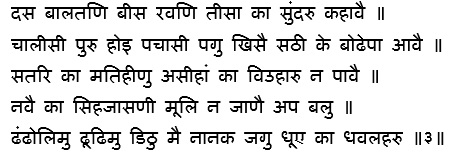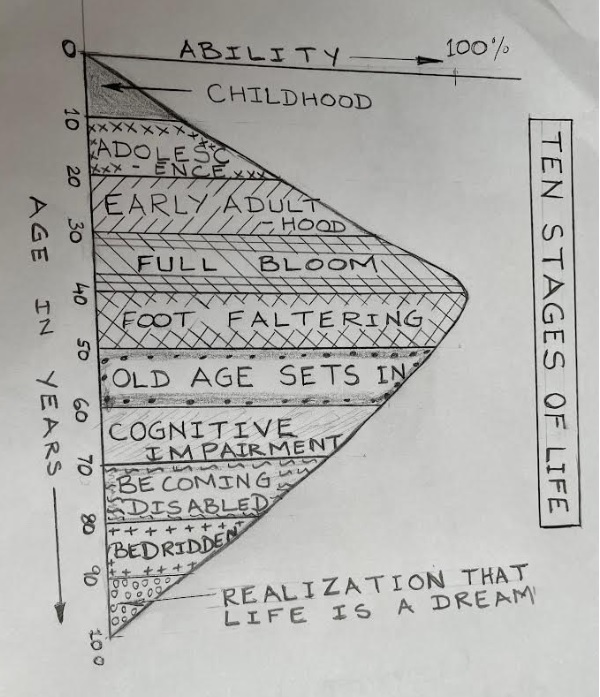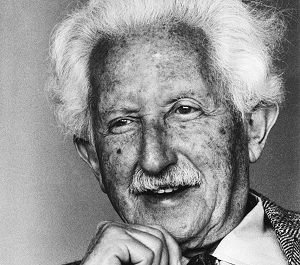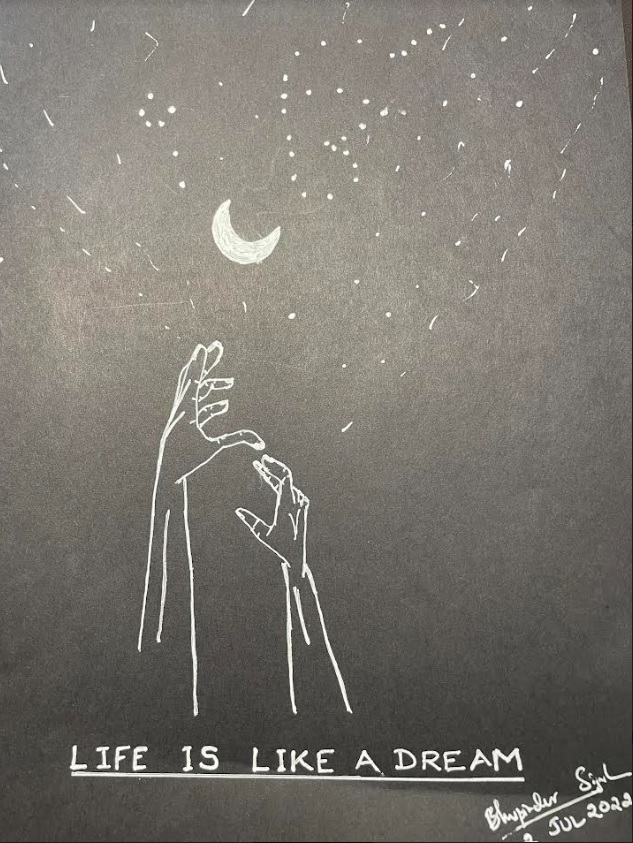Dec 26, 2025
Dec 26, 2025
The AARP Bulletin ran an article Titled “The New Truth About Aging” in the June 2022 issue where they discussed about the Life Stages. In that article the very first sentence on life stages read “Midlife Crisis, Move Over.” In that article they talked how the attitudes about longevity, relationships, well-being, and wealth have shifted. There they asked is 60 the new 40. This started the exploration on the various life stages. I discovered that Guru Nanak Dev Ji, had defined the ten stages of human life, each a decade long. What impressed me about the 10 stages was that each stage was a decade long and the reality shared there could be experienced even today in real life. Let me first share the shabad:

Dhas baalatan bees ravan teesaa kaa sundhar kahaavai.
Chaaleesee pur hoi pachaasee pag khisai saThee ke boddepaa aavai.
Satar kaa matiheen aseehaan kaa viauhaar na paavai.
Navai kaa sihajaasanee mool na jaanai ap bal ||
Dda(n)ddolim ddooddim ddiTh mai naanak jag dhooe kaa dhavalahar. 3. – (SGGS, Pg. No. 138)
Translation:
First ten (years are spent) in childhood, twenty in playfulness, and at thirty is called beautiful (handsome).
At forty, the completeness occurs; at fifty, the foot falters; at sixty, the old age sets in.
At seventy, the intellect takes a hit; at eighty, the ability to take care of self is impaired.
At ninety, becomes bedridden, incapacitated, unable to take care of self without assistance.
Nanak: I searched, I searched, and I found that this world is a mansion of smoke (visible one moment and then gone next moment).

Let us try to understand what Guru Ji is saying about each of these 10 stages of life:
The ten stages as defined by Guru Nanak Ji are shared here in the Tabular form here.
| Ten Life Stages | |||||||||||||||||||||||||||||||||||||||||||||||||||||||
|
The English Terms used here in translation above to describe the life stages have been picked from the commonly used words and in prevalent parlance, so these are not literal translation of the terms used by Guru Ji.
 The scientific world has accepted the 8 Stages as defined by Erik Erikson of Germany in 1950. He was a developmental Psychologist, who is best known for his theory of psychosocial development. The first four stages defined by him are covered in the first stage by Guru Ji. His fifth stage can be more or less can be equated to Guru Ji’s stage 2. His sixth stage is covered by Guru Ji’s division in stages 3 and 4. Erikson’s seventh stage can be related to stages 5, and 6 plus 7 partially. Erikson’s last stage 8 envelopes everything over the age of 65, while Guru Ji has covered it in three stages of 8, 9, 10 fully and 7 partially. As Erikson was 48 when he shared his work that implies that his stage 8 termed as Older Adulthood was not borne out of personal experience. I feel that there would have been 3 to 4 additions if it was actually experienced like his childhood stages. Generally, the society lumps these stages together, being labeled as ‘seniors’ or ‘the elderly’. The implications of these terms are not reverential, but a gentle reminder of having become redundant. Lest we forget we all are going to witness it firsthand ourselves, only if we manage to live that long.
The scientific world has accepted the 8 Stages as defined by Erik Erikson of Germany in 1950. He was a developmental Psychologist, who is best known for his theory of psychosocial development. The first four stages defined by him are covered in the first stage by Guru Ji. His fifth stage can be more or less can be equated to Guru Ji’s stage 2. His sixth stage is covered by Guru Ji’s division in stages 3 and 4. Erikson’s seventh stage can be related to stages 5, and 6 plus 7 partially. Erikson’s last stage 8 envelopes everything over the age of 65, while Guru Ji has covered it in three stages of 8, 9, 10 fully and 7 partially. As Erikson was 48 when he shared his work that implies that his stage 8 termed as Older Adulthood was not borne out of personal experience. I feel that there would have been 3 to 4 additions if it was actually experienced like his childhood stages. Generally, the society lumps these stages together, being labeled as ‘seniors’ or ‘the elderly’. The implications of these terms are not reverential, but a gentle reminder of having become redundant. Lest we forget we all are going to witness it firsthand ourselves, only if we manage to live that long.
Based on the above usage of terms for the 10 stages, today I would personally belong to stage 8: implying Bedridden. If someone attempted to apply that term to me, I would not find that amusing. But here is a caveat, I will not be in a denial mode either. Because I have actually only experienced 25%, and yet to experience the remaining 75% of that stage, so I don’t have any basis to take a stand. Based on the data the life expectancy is around 80. In addition, the remaining two stages are like a black box - unknown. So, I cannot take a victory lap too early. There is no denying that my physical strength, mental agility, vigor, and my memory have seen a decline from the prime. In any case, the remaining two stages, namely 9 and 10 are scarier options, yet only very few make it to these stages. In spite of its loathsome welcome, only very few get to actually undertake it. Guru Tegh Bahadur Ji has painted that picture in these words:

“Sii-r kameyo pagh daghmaghe, nai-nn jyot te hee-n.
Kaho Nanak eh bidh ba-hee, ta-oo na Har ras lee-n. 47.” – (SGGS, Pg. No. 1428)
Translation: Oh Brother! In old age the head shakes, the feet stagger, the eyes lose sight, despite this condition the man does not absorb himself in the taste of God’s Naam.

Guru Ji has rightly pointed out above that I have “na Har ras lee-n”. Really true, that I have not tasted the Divine nectar. But then where do I look for scour now? The only alternative, I see for myself is to run to my Guru Ji seeking help as:
![]()
“Baajh guroo ddubaa sa(n)saar. 2.” – (SGGS, Pg. No. 138)
Translation: Without the Guru, the world is drowning. ||2||
The life of Guru Amardas provides us hope and inspiration. Bhai Amardas came to Guru Angad at age around 62, and in 12 years with his dedication, service, and commitment, had won over Guru Ji’s heart. At 73, he was anointed as the successor to Guru Angad and successfully led the community of followers. Guru Amardas lived till the age of 95 without any old age impairment and led a rigorous life. He contributed 907 hymns to Sri Guru Granth Sahib. He set up Masand system of preacher/ representatives and assigned them different territories for preaching and also set up set up a city of Goindval. His own sayings fills me with hope:

“Gurmukh budde kadhe naahee jin(h)aa a(n)tar surat giaan.
Sadhaa sadhaa har gun raveh a(n)tar sahaj dhiaan.” – (SGGS, Pg. No. 1418)
Translation: The Gurmukhs never grow old as within them is intuitive understanding and spiritual wisdom. They chant the Praises of the Lord, forever and ever; deep within, they intuitively meditate on the Lord.
His own life, his own experience as shared above is my only inspiration and hope. I have not climbed up on the spirituality ladder nor chant God’s praises, still I have come to seek your sanctuary. I have nothing else in my repertoire, Guru Ji, so please bless me with the spiritual wisdom and mediation on the Lord. Knowing that you are very compassionate I have set my eyes on you:

“Eih sareer jajaree hai is no jar pahuchai aae.
Gur raakhe se ubare hor mar ja(n)mai aavai jaae.” – (SGGS, Pg. No. 584)
Translation: This (human) body is frail (breaks upon sudden impact like an earthen pot); death is ready to strike it dead in (the vulnerable) old age. Only those who are protected by the Guru are saved, while others die, to be reincarnated as they continue coming and going.
My only hope is in protection by the Guru and mercy of God. My Guru has also told me about the merciful and benevolent nature of God in these words:
![]()
“Nanak saahib sadhaa dayal. 2.” – (SGGS, Pg. No. 268)
Translation: O Nanak, our Lord and Master is merciful forever. ||2||
May Guru Ji’s guidance and mercy of God save us from the cycles of births and deaths so that we don’t have to go through these different stages of life again. Although, the old age is debilitating, it incapacitates us of our physical strength, making us dependent, but we have hope in mental and spiritual fortitude which Guru can bless us with. It is not dependent on the chronological age, nor loses its potency with age. That fortitude enables us to handle even the trying times with poise and without a complaint. Guru Amardas has painted the picture in these words:
 “Oi sadhaa ana(n)dh bibek raheh dhukh sukh ek samaan.
“Oi sadhaa ana(n)dh bibek raheh dhukh sukh ek samaan.
Tinaa nadharee iko aaiaa sabh aatam raam pachhaan. 44.” – (SGGS, Pg. No. 1418)
Translation: They dwell forever in blissful knowledge of the Lord; they look upon pain and pleasure as one and the same. They see the One Lord in all, and realize the Lord, the Supreme Soul of all. ||44||
References:
Illustrations by the author
17-Sep-2022
More by : Bhupinder Singh